NIL
The next conquest

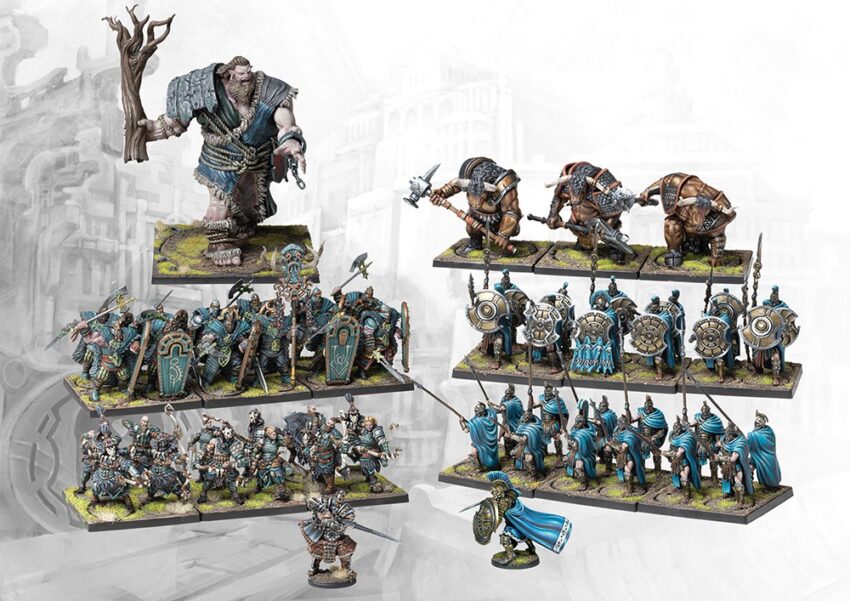
Of all the stellar throws Jake Fette made in 2024 — and there were a bevy of them during the Del Valle High School quarterback’s junior year, a campaign that saw the Conquistadores complete their first undefeated regular season in more than two decades — it was a set of tosses during a seemingly innocuous January workout that have reverberated. The plays touched off a frenetic 16-month period that placed the 17-year-old football phenom amid a national conversation.
That day, Kirk Bryant, then an assistant coach at Texas Tech, was in El Paso with a small contingent of Red Raider coaches to scout potential high school talent. As Del Valle head coach Rudy Contreras recalled, Bryant was getting ready to catch a flight out of the city on the heels of a conversation about a “pretty good quarterback” Contreras wanted him to see. Bryant’s flight, however, got delayed. And he reached out to Contreras to ask if he could make an unplanned visit to the Del Valle campus.
“I said, ‘We’re about to go out here and throw a little bit,’” Contreras said. “Yeah, come back.”
Bryant did more than see.
 Del Valle High School quarterback Jake Fette throws a pass as the team warms up for a spring scrimmage, May 22, 2025. (Corrie Boudreaux/El Paso Matters)
Del Valle High School quarterback Jake Fette throws a pass as the team warms up for a spring scrimmage, May 22, 2025. (Corrie Boudreaux/El Paso Matters)
“After about four throws,” Contreras said, “(Bryant) said, ‘Hold on,’ and took out his phone, started recording.”
Bryant began FaceTiming other Texas Tech coaches, offering them a virtual glimpse of the 6-foot-2, 180-pound player who threw for 2,488 yards that fall en route to a third consecutive District 2-5A title. After the session, the coaches convened and Bryant told Contreras, “This kid is the real deal. He could be at Texas Tech and be our third best quarterback right now.”
Before the group headed back to the airport, Texas Tech extended an offer, the first of numerous schools over the last year-and-a-half that offered Fette a scholarship to play collegiately. Bryant also had some prophetic parting words for Contreras.
“He said, ‘Coach, I want you to remember we were the first ones to offer him because it’s going to get crazy here in the next couple of years,’” Contreras said. “I thought he was exaggerating. I was thinking maybe we get a couple more schools. But, two years later and, yeah, it’s been crazy.”
Fette’s story captures a transformative moment in high school and college football. As he prepares to compete this week in the prestigious Elite 11 Finals quarterback competition, he’s also navigating a recruiting process shaped by seismic shifts in college athletics. The rise of name, image and likeness compensation has rewritten the rules of recruitment and athlete branding.
Setting the stage
As a junior, Fette was unflappable, throwing for 32 touchdowns and rushing for 11 more in leading Del Valle to its second undefeated regular season in school history. In the UIL Class 5A state football playoffs, the Conquistadores became the first El Paso program to defeat Abilene Cooper in the postseason. Fette threw for over 200 yards and three touchdowns while also running for two scores. He threw his lone interception of the season in the subsequent area-round loss to Lucas Lovejoy.
 Jake Fette, the Del Valle quarterback who is currently ranked 4th nationally, walks off the field during a spring scrimmage, May 22, 2025. (Corrie Boudreaux/El Paso Matters)
Jake Fette, the Del Valle quarterback who is currently ranked 4th nationally, walks off the field during a spring scrimmage, May 22, 2025. (Corrie Boudreaux/El Paso Matters)
Fette’s story took another major turn in September 2024, just as the season was getting underway. With Del Valle off to a 3-0 start and Fette already compiling 612 passing yards and 148 rushing yards — including wins over Franklin and Canutillo — he announced his verbal commitment to Arizona State on social media.
This week, Fette will be in Los Angeles to compete in the Elite 11 Finals — one of the country’s most prestigious quarterback competitions for high school seniors. The invite-only event June 17-19 at Mira Costa High School will bring together 20 of the nation’s top prospects for advanced training, on-field evaluation and leadership development. Fette is the only quarterback from the El Paso area selected to compete and will represent Del Valle among peers already committed to programs such as Texas, Clemson, Penn State and USC.
Fette chose ASU over offers from Kansas, SMU, Houston, Texas Tech, New Mexico State, Texas State, California and UTEP. His feats on the field have drawn national renown. This spring, Fette was named the No. 4 quarterback prospect in the nation in the Class of 2026 by On3 Recruits, a leading sports publication that tracks high school and college athletics.
“Jake is a great person, and he’s a great college prospect,” Contreras said. “This is a decision he took time in making and he’s got our full support here at Del Valle. He has so much promise as a player and he puts in the time to get better. He is a leader for us.”
Players to watch
Other El Paso high school football seniors drawing interest from Power Four college football programs:
Justin Morales
- School: Franklin
- Position: Offensive line/defensive line
- Size: 6-foot-4, 265 pounds
- Recruited by: Arizona, California, Kansas State, Michigan State, Oregon State, UTEP, Wisconsin
- Verbal commitment: Kansas State
Ryan Estrada
- School: El Dorado High School
- Position: Running back
- Size: 6-foot, 195 pounds
- Recruited by: Alabama, California, Michigan, Minnesota, Missouri, Oklahoma State, Wisconsin
- Verbal commitment: None
Fette’s journey is unfolding in an era of historic change in college athletics. Since 2021, NCAA rules have allowed college athletes to profit from their name, image and likeness — a legal right often referred to as NIL. This means student-athletes such as Fette can now earn income through endorsements, social media, autograph signings and personal appearances, all while in college.
For top-tier prospects, NIL is a key part of the recruiting conversation. College programs are increasingly evaluated not just for their coaching and facilities, but for the strength of their NIL infrastructure — including what kind of opportunities and support they offer athletes. While Texas currently does not allow high school athletes to enter into NIL deals, prospects such as Fette are already being recruited into environments where those opportunities are front and center.
Athletes and their families must now navigate an unfamiliar mix of traditional sports decision-making and modern brand-building. For Fette and his family, this balancing act has played a central role in the decisions they’ve made and how they’ve approached the spotlight.
Stay informed. Stay empowered. Get the in-depth, local reporting El Paso deserves—straight to your inbox. Sign up for our free weekly newsletter today.
From the ground up: Early days and athletic roots
Jake Fette’s athleticism showed itself early, according to his father. From YMCA basketball games to flag football and soccer, he dabbled in everything.
“He was always good at sports,” said Rick Fette. “Always a little bigger, faster than the other kids. It was just fun. He had fun doing it and we had fun watching him.”
The elder Fette recalled Jake’s transition to quarterback came unexpectedly. In 2019, Del Valle’s previous head coach, Jesse Perales, left for the same position at Garland Naaman Forest. Perales’ son, DeAngelo, was the quarterback of the sixth-grade youth team where Jake played wide receiver.
“They tried out a few guys and realized (Jake) could throw a lot farther than they could,” Rick said.
Initially, the position change was jarring for the younger Fette.
“To be honest, I didn’t even like it at first,” Jake Fette said. “But, being able to control the game, I really like. I like having the ball in my hands and I get to make the decisions that choose the outcome of the game.”
 The Del Valle High School football team stretches before a spring scrimmage, May 22, 2025. (Corrie Boudreaux/El Paso Matters)
The Del Valle High School football team stretches before a spring scrimmage, May 22, 2025. (Corrie Boudreaux/El Paso Matters)
Rick Fette, who played at UTEP, was cautious but observant as the years progressed.
“I knew very little about quarterbacking,” he said. “But, I saw he looked like one of the better ones. Strong arm, moved well, decent size.”
That mix of tools, versatility and parental guidance became more evident as he reached high school.
“His coaches liked him,” Rick Fette said. “We knew that people were going to be more receptive to a kind, polite kid that’s got his manners.”
A coach and a father
Rick Fette brings a unique perspective — he is both Jake’s father and one of his team’s coaches. The elder Fette, who played football at Flour Bluff High School in Corpus Christi, has been an assistant defensive coach at Del Valle for 16 years.
He arrived in El Paso to play defensive end for UTEP in 1999 and was part of the Miners’ 2000 Western Athletic Conference championship team. Rick Fette said he chose UTEP over North Texas, Air Force and SMU because of the demeanor of then-defensive line coach Lorenzo Constantini, but also because of what he perceived as the success of the school’s strength and conditioning program.
“I thought, ‘Man, the guys are huge here,’” Rick Fette recalled of former UTEP players such as Brian Young and Paul Smith, both of whom played in the NFL. “It felt like an impressive club to be a part of.”
.wp-block-newspack-blocks-homepage-articles article .entry-title{font-size: 1.2em;}.wp-block-newspack-blocks-homepage-articles .entry-meta{display: flex;flex-wrap: wrap;align-items: center;margin-top: 0.5em;}.wp-block-newspack-blocks-homepage-articles article .entry-meta{font-size: 0.8em;}.wp-block-newspack-blocks-homepage-articles article .avatar{height: 25px;width: 25px;}.wp-block-newspack-blocks-homepage-articles .post-thumbnail{margin: 0;margin-bottom: 0.25em;}.wp-block-newspack-blocks-homepage-articles .post-thumbnail img{height: auto;width: 100%;}.wp-block-newspack-blocks-homepage-articles .post-thumbnail figcaption{margin-bottom: 0.5em;}.wp-block-newspack-blocks-homepage-articles p{margin: 0.5em 0;}.wpnbha.ts-3 .entry-title{font-size: 1em}.wpnbha.ts-3 article .newspack-post-subtitle,.wpnbha.ts-3 article .entry-wrapper p,.wpnbha.ts-3 article .entry-wrapper .more-link,.wpnbha.ts-3 article .entry-meta{font-size: 0.8em;}
Rick Fette was part of stalwart defensive line units that produced NFL draft picks Leif Larsen and Menson Holloway. He said apart from his teammates, he was also impressed with the school’s amenities.
“It felt really big-time,” Rick Fette said. “When I was at UTEP, we had trainers giving us water. We had cold water in all our drills. It felt like I was in the NFL.”
That sense of professionalism, structure and preparation has shaped how he has helped guide his son through the recruiting and NIL maze.
“There’s two ways we could probably do it right now,” Rick Fette said of NIL. “You can go get an agent and have that agent go to work for you and shop you around to the highest bidder … or you go where you want to go.”
Rick Fette said they preferred the second approach — focusing on fit, relationships and values.
What Rick Fette saw in Arizona State was a program that was building the right way.
“Their background in general … what they were talking about and what they were doing even before they had a really good season, it all kind of made sense,” he said.
 Jake Fette, the Del Valle quarterback who is currently ranked 4th nationally, has verbally committed to Arizona State University, May 22, 2025. (Corrie Boudreaux/El Paso Matters)
Jake Fette, the Del Valle quarterback who is currently ranked 4th nationally, has verbally committed to Arizona State University, May 22, 2025. (Corrie Boudreaux/El Paso Matters)
The Arizona State commitment
Jake Fette committed to Arizona State as his junior year at Del Valle got underway — before the Sun Devils’ surprise run to the 2024 College Football Playoff.
At the time, ASU was coming off a 3-9 season and was picked to finish at the bottom of the Big 12 Conference in preseason rankings. But as the 2024 college football season unfolded, the Sun Devils shocked the country.
Behind the leadership of second-year head coach Kenny Dillingham and breakout performances from players such as quarterback Sam Leavitt and running back Cam Skattebo, ASU won the Big 12 championship and earned a berth in the inaugural postseason tournament. In the Peach Bowl quarterfinal, they pushed national powerhouse Texas to double overtime before falling 39-31.
Leavitt’s postseason success elevated him to national prominence — and, according to On3, a top-10 NIL valuation of $3.1 million.
Despite the meteoric rise of ASU and Leavitt’s emerging stardom, Jake Fette said he has not wavered in his commitment even as schools continue to make overtures.
“I was committed to stay committed,” he said. “I wasn’t looking to flip or anything. You know, for them to have a season like they did, it just made me more and more excited to be a part of that program.”
Jake Fette said he was impressed not just by the system, but by the authenticity of the coaches. In addition to Dillingham, Fette was courted by offensive coordinator and quarterback coach Marcus Arroyo, who has coached numerous NFL quarterbacks, including the San Diego Chargers’ Justin Herbert.
“They’re gonna tell you what it is and how it is,” Jake Fette said. “I really appreciate that. Just telling me, like, I’m not guaranteed to play or any of that, but just the fact that they’ll work with me and not lie to me.”
Contreras saw the effect ripple beyond just Jake.
“Jake Fette is spearheading that ’26 class,” Contreras said. “Now, they have a lot of commits because of Jake Fette, so they’re going to be very talented in the upcoming future.”

NIL in focus
As the family learned more about NIL, they stayed focused on the long-term benefits rather than immediate payouts, Rick Fette said.
“Now you’ve got to basically show proof of value,” Rick Fette said. “They’re trying to follow kind of an NFL model on it.”
He pointed out that most players aren’t raking in millions — despite headlines.
“That’s a very, very select view of, like, five-star guys that they think, ‘This guy’s generational,’” he said.
On June 6, a major shift in the NIL landscape was made official with the ratification of the House v. NCAA settlement. The class-action lawsuit, brought by former college athletes including Arizona State swimmer Grant House, challenged the NCAA’s longtime restrictions on athlete compensation and forced a landmark agreement that will allow schools to share revenue directly with players for the first time.
Starting July 1, universities will be allowed to directly pay athletes through revenue-sharing agreements. Power conference schools such as Arizona State are expected to allocate up to $20.5 million annually across their athletic departments, with football projected to receive the lion’s share.
The Sun Angel Collective, the official NIL collective of Arizona State athletics, did not respond to a request for general information on how it will conduct operations during the 2025-26 athletics season.
This pay-for-play model marks a new era in college sports. Compensation is expected to be governed by a College Sports Commission, which will enforce caps and ensure NIL deals meet fair market standards. While athletes will remain classified as non-employees, their compensation could reach levels once unthinkable in college athletics. NIL contracts will be vetted through a clearinghouse run by Deloitte, with booster-funded deals facing increased scrutiny.

For Jake Fette, this means he will enter college amid a structured, high-stakes NIL system. While he has not spoken publicly about pursuing NIL deals, the infrastructure surrounding him will change significantly by the time he arrives in Tempe.
And through it all, the family’s guiding principle has remained steady: “He made that decision for the right reasons early on,” Rick Fette said.
Contreras agreed.
“The process and the steps that Jake has taken to get to where he’s at … he’s never asked about money,” he said.
Lessons from the past: Advice from El Paso’s quarterback trailblazers
Jake Fette isn’t the first El Paso quarterback to draw national attention — but his journey is unfolding in a landscape far different from those navigated by Steven Montez and Ed Stansbury.
Montez, also a Del Valle alumnus now living in northern California, graduated in 2015 and played at the University of Colorado and later in the NFL with the Washington Football Team. He sees continuity in the school’s culture of quarterback development.

“Even before me, Del Valle was already kind of a powerhouse and a QB factory,” Montez said. “Jordan Baeza, Tury Rios, Adrian Gonzalez — all those dudes had really good runs into the playoffs and played high-level football.”
Montez believes the longevity in the school’s coaching staff is at the heart of that legacy.
“They’ve managed to keep that staff relatively intact. We had a ton of high-level coaches who taught us how to play the game and play it at a high level.”
Asked about Fette, Montez didn’t hesitate: “He’s a phenomenal player in his own right. His accuracy at his age is much farther along than I was. He spins the hell out of the ball. There’s really no weaknesses in his game.”
Stansbury, who graduated from Irvin High School in 1997, and played at UCLA and in the NFL with the Houston Texans, also sees Fette’s character as a difference-maker.

“He’s active on social media, but he’s in no way showing off or taking advantage of the situation,” Stansbury said. “It’s been all business for Jake.”
Stansbury said his own recruiting journey was different: “A lot of my success and my exposure was due directly to my high school football coach (Tony Shaw) … he spent countless hours sending out VHS tapes.”
Now, watching NIL transform the landscape, Stansbury said Fette is handling it the right way.
“What parents and players can take away from Jake is how he has conducted himself,” Stansbury said. “The humbleness he’s carried throughout this speaks volumes.”
These lessons carry personal relevance for Stansbury, too. His son, West Stansbury, is an up-and-coming quarterback at Coronado High School. As West enters his sophomore year and begins what could become his own recruiting journey, Ed is already thinking about how to prepare him for a future that includes the realities of NIL.
“We’ve built his brand pretty good for what he’s done so far,” Stansbury said. “Now the second part is being a productive, good athlete that colleges want. The NIL opportunities will follow if those things are done. Jake’s journey shows how to do it right.”
Both Montez and Stansbury emphasized that the spotlight brings pressure, but Fette appears well-prepared.
“Just don’t let anybody take your confidence away,” Montez said. “He knows he’s a great quarterback. He just has to keep pushing to be great — and he will.”
What comes next
Jake Fette will graduate in December and enroll at Arizona State in the spring of 2025, giving him a head start to learn the playbook and adjust to the pace of college football. But before that, he has one final high school season to complete.

“Last season doesn’t matter anymore, so we’ve got to prove that we’re good again,” Fette said. “I don’t think anyone’s expecting us to be as good as we were last year with all the graduates, but we’re reloaded. We’re not rebuilding.”
His preparation for his senior season, which begins Aug. 29 against Montwood High School, continues.
“I’m just gonna stick to what I’ve been doing,” he said. “Regularly work out and just get my mind ready to go.”
Contreras is already thinking ahead.
“We’re gonna miss his talent and everything he does on the field, but we’re also gonna miss the way he represents Del Valle football, the leadership he brings to this team in the locker room, the way he carries himself in the building,” he said.
As for Jake Fette, he remains focused on what matters most.
“At the end of the day, I’m going to college to play football because I love football,” he said.
For his school, his city, and the next wave of El Paso athletes, he has shown what the new standard can look like.
“Football ends at some point or another for everybody,” Contreras said. “But to know that he has some money to kind of start his life on — his adulthood on — who knows, maybe the rest of his life. It’s a good deal for them. And we’re proud.”

NIL
Dick Vitale, Charles Barkley call out College Football Playoff committee over Notre Dame snub

Six days after Notre Dame missed the College Football Playoff, the Fighting Irish’s absence is still a point of conversation. During Saturday’s Kentucky vs. Indiana basketball game, Dick Vitale and Charles Barkley shared their reaction, calling out the CFP committee in the process.
Vitale, of course, wears his Notre Dame fandom proudly. He spoke out on social media shortly after the final rankings came out this week, when the Fighting Irish became the first team out of the CFP while Miami jumped up to No. 10 due to the head-to-head matchup between the two teams.
As ESPN showed a promo for this year’s College Football Playoff, Vitale made his thoughts clear. He argued Notre Dame deserved to be in the bracket, especially considering the Irish were in that position throughout the five weeks of CFP rankings shows.
“I’m so frustrated looking at that, Notre Dame not in there,” Vitale said on the broadcast. “Notre Dame deserved to be in.
“Five weeks in a row, we have a show on ESPN where we give the Top 12 teams, make a big thing out of it every Tuesday. Big show. Here comes the committee. Bottom line is, they were all five [weeks] in the Top 12. Then, all of a sudden, bumped.”
Charles Barkley: ‘You could see’ Notre Dame absence coming
Charles Barkley agreed with Dick Vitale, expressing his disappointment with Notre Dame’s absence. However, he said it might not have been entirely surprising considering the penultimate rankings announcement. The Fighting Irish dropped to No. 10 while Alabama moved to No. 9. BYU sat at No. 11, putting a team between Notre Dame and Miami, therefore avoiding the head-to-head discussion.
That said, Barkley argued Notre Dame is a different team than it was when it played Miami in Week 1. As a result, he thought the Irish should have been in the field.
“I actually agree with you. … I was disappointed,” Barkley said. “But you could see it coming in the last couple polls. They were creeping up on Miami. And my biggest problem with the whole thing, everybody’s talked about head-to-head. First of all, that was in August. … They were very close games [against] A&M and at Miami.
“But your team is not the same in August as it is in December. Notre Dame is playing as well as anybody in the country other than Indiana and probably Ohio State. And I don’t want to leave out the [Georgia] Bulldogs. Kirby Smart, that man can really coach.”
NIL
2026 Heisman Trophy: CBS Sports names front-runners for the college football’s top award

The 2025 Heisman Trophy race is in the books, and now the college football world can turn its attention to the 2026 Heisman Trophy race. There, it should be a highly competitive race with several players set to return who look like candidates for college football’s top award.
Ahead of the 2026 season, CBS Sports took a look at those candidates. That included sorting them into two categories. That’s the top Heisman contenders for the 2026 season and other names to know for the race. Of course, there’s plenty of room for surprises beyond that too.
Several players who CBS Sports lists could be on the move next season. That includes in the Transfer Portal or going into the NFL Draft. So, with the offseason just around the corner, there’s time for things to change.
Top Heisman contenders in 2026
Arch Manning, QB, Texas Longhorns
Texas Longhorns quarterback Arch Manning got his first action as a starter in 2025. That moment had been highly anticipated since he was in high school and it came with mixed results. Still, with another year of experience, he very well could contend for the Heisman Trophy.
Of course, Manning does have the option to enter the NFL Draft. That’s not what most people anticipate, though, as returning to Texas for another season should help him improve that stock. Certainly, being a Heisman winner wouldn’t hurt either.
Julian Sayin, QB, Ohio State Buckeyes
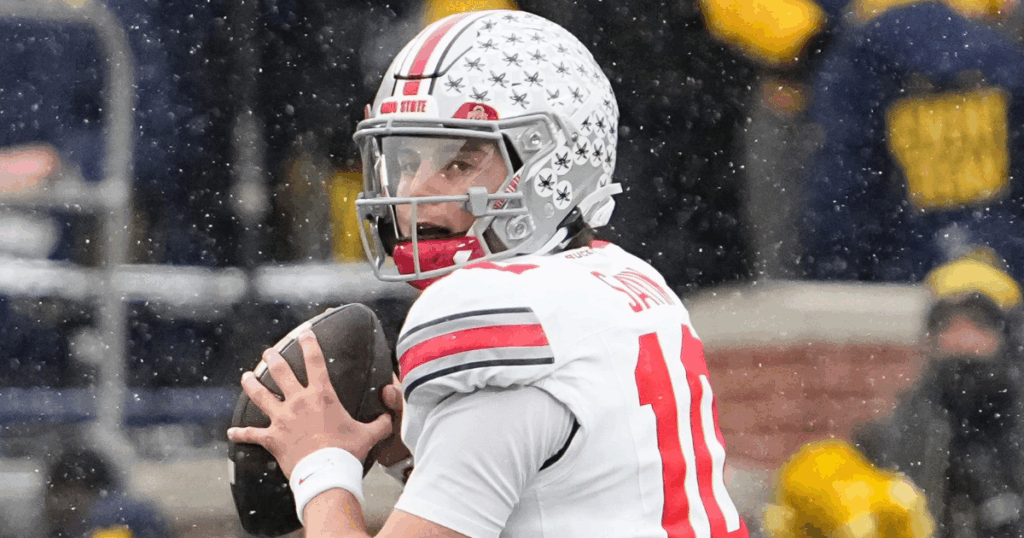
It was a disappointment in New York for Ohio State quarterback Julian Sayin. A Heisman finalist this season, he didn’t end up going home with the hardware. Instead, he’ll have to refocus on the College Football Playoff and winning on the field.
As a redshirt freshman, Sayin was a Heisman finalist. He’ll be back again in 2026 with added experience that is almost impossible to find in college football. So, there’s no reason why he can’t win.
Jeremiah Smith, WR, Ohio State Buckeyes
Coming into the 2025 season, Jeremiah Smith was commonly thought of as the best receiver in all of college football. He wouldn’t end up winning the Biletnikoff Award or being a Heisman finalist, though he was still thought of as the most talented receiver in the country.
Just a sophomore, Smith will be back next season and will, once again, be among the most thrilling players in the game. The only concern is whether or not he and Sayin will steal Heisman votes from one another.
Marcel Reed, QB, Texas A&M Aggies
Marcel Reed has been a revelation at quarterback for Texas A&M. The Aggies’ signal caller led Texas A&M to the College Football Playoff and has made them a legitimate threat to win the national championship. He’d use both his arm and legs to get there too.
As one of the most exciting players in the game who plays on a massive stage in the SEC, Reed is going to have the spotlight on him in 2026. If he plays up to his capability, he’ll be in the Heisman conversation once again. There’s no reason to think he can’t win it too.
Jayden Maiava, QB, USC Trojans
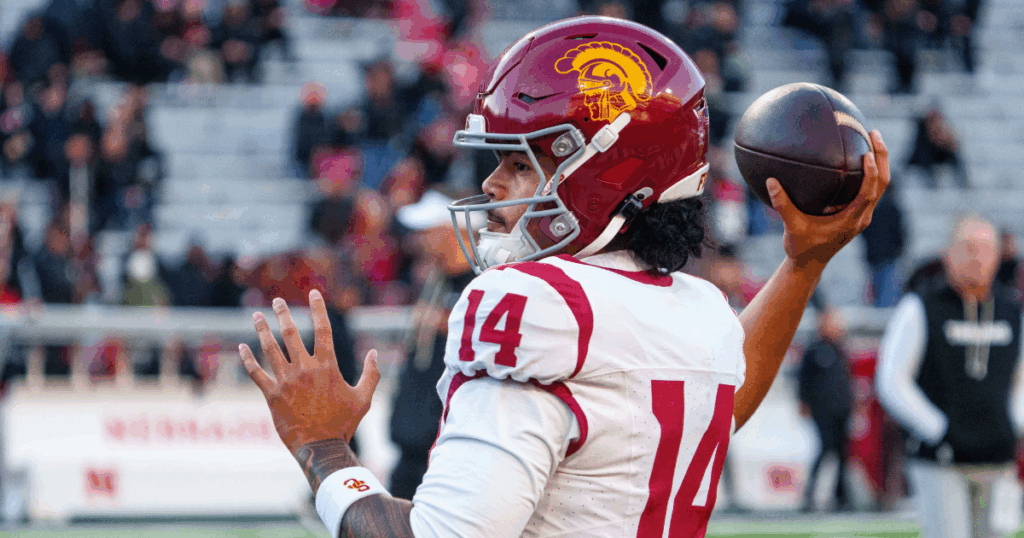
After taking over as the USC starter late in 2024, Jayden Maiava would hit his stride in 2025. Now, he and head coach Lincoln Riley are looking for a way to build on that once again.
If there is one thing that Lincoln Riley has found success doing it’s developing quarterbacks and explosive offenses. That’s led to Heisman Trophy success, including at USC. So, it’s not unfair to have high expectations for next season.
Other names to know
Ty Simpson, QB Alabama Crimson Tide
Alabama quarterback Ty Simpson is eligible to turn his attention to the NFL Draft next season. If he chooses to return to college, though, Simpson is going to be viewed as one of the best quarterbacks in the entire sport. He could very well even be a Heisman contender.
Gunner Stockton, QB, Georgia Bulldogs
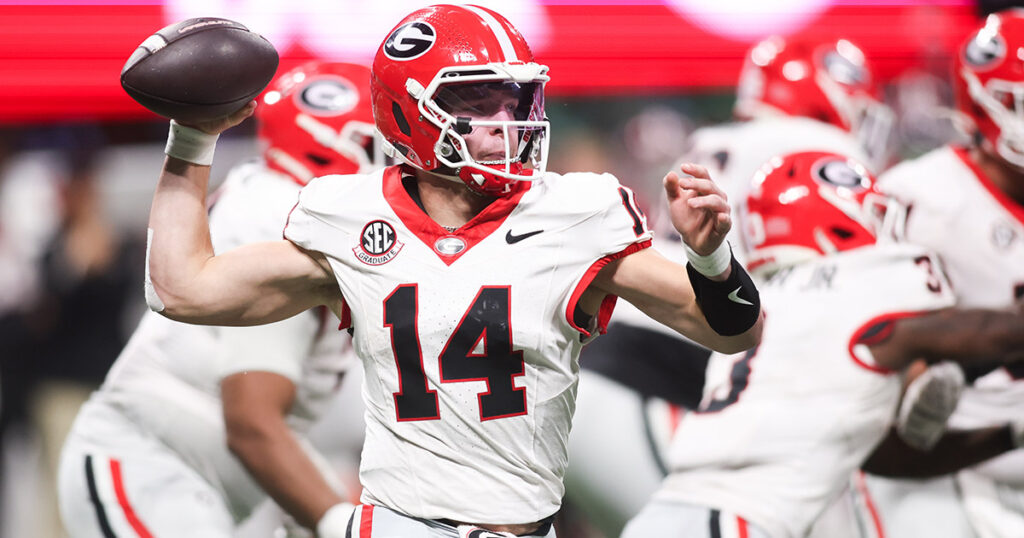
Georgia managed to win the SEC and a first round bye in the first season Gunner Stockton led the Bulldogs as their starting quarterback. He’ll likely be back next season with much higher expectations from the jump. So, he could feasibly end up in the Heisman race more so than he was in 2025.
Drew Mestemaker, QB, North Texas Mean Green
There is a chance that Drew Mestemaker could be a transfer this offseason, as his head coach is on his way to Oklahoma State. That comes after the pair combined for a phenomenal season at the Group of Five level. With more attention on him from the start, regardless of where he’s playing, the Heisman isn’t out of the question.
Sam Leavitt, QB, Arizona State Sun Devils
For the past two seasons, Sam Leavitt has been vital to making Arizona State one of the best teams in the Big 12. Now, there are rumblings that he could transfer. Regardless of where he ends up, Leavitt should be a Heisman contender.
Ahmad Hardy, RB, Missouri Tigers
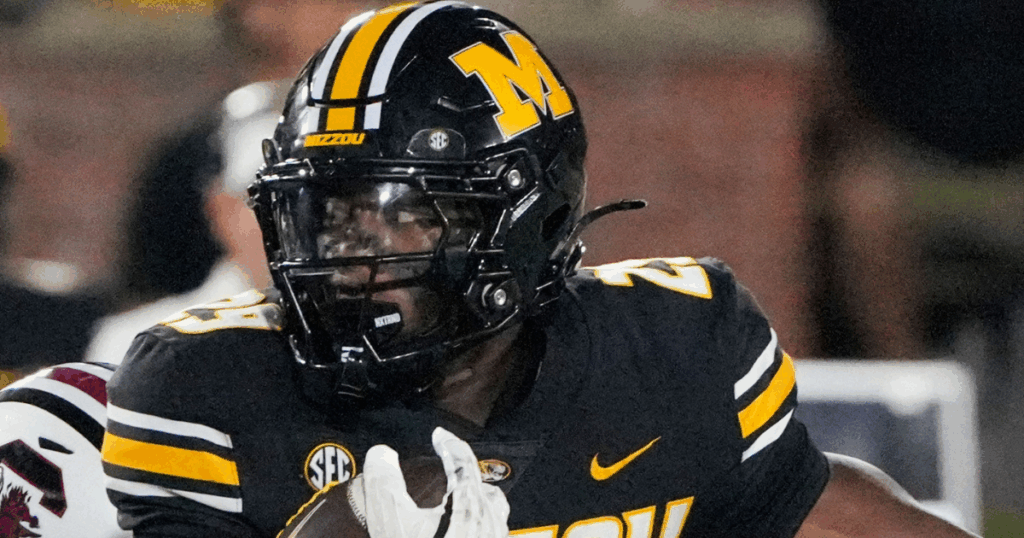
The Missouri Tigers managed to find one of the best running backs in the entire country this season, bringing in Ahmad Hardy. He’d rush for 1,560 yards and 16 touchdowns in 2025. If he can build on that in 2026, the Heisman may not be able to ignore his success.
Kewan Lacy, RB, Ole Miss Rebels
Another running back to keep an eye out on for the Heisman race next season is Kewan Lacy. The Ole Miss running back had 20 rushing touchdowns this year. That’s hard to ignore, but it’s also hard to replicate.
NIL
Dan Lanning Reveals Reasoning Behind His Loyalty to Oregon
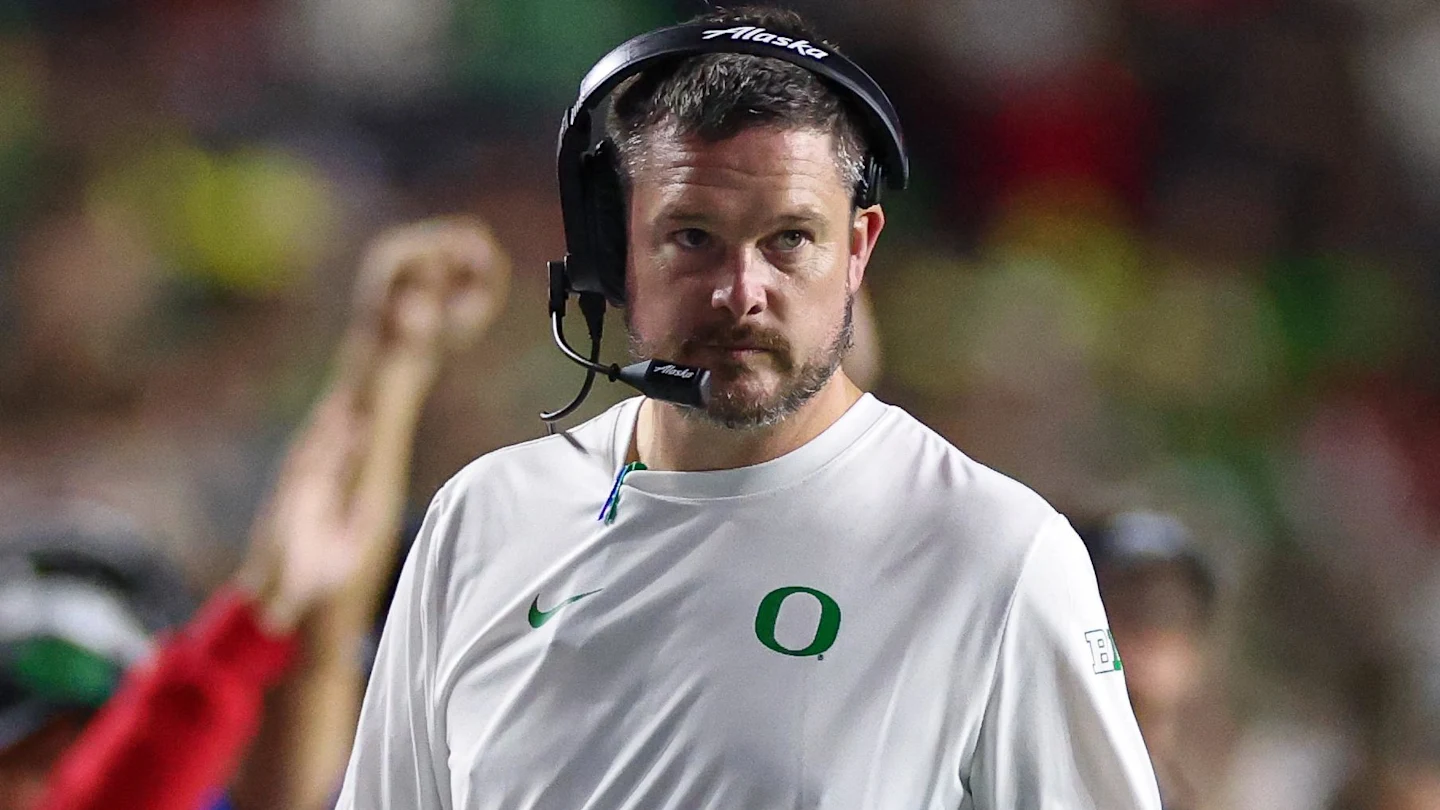
Dan Lanning has been asked many times since 2022 if he’d leave the Oregon Ducks for another head coaching job. While rumors have swirled pertaining to college football openings, a position in the NFL is something that could’ve lured Lanning away from Eugene in the past.
But the Ducks’ coach revealed on The Inner Circle Podcast that his former aspiration of coaching at the professional level is old news.
Dan Lanning Remains Committed to Oregon

Lanning spoke about how he started writing his career goals on his mirror when he was at Arizona State.
“I still put my goals on my mirror,” he said. “No. 1 best father on staff, best husband on staff, man of integrity, Christian, five recruits.”
Lanning, who was a graduate assistant for the Sun Devils, wanted to become a full-time employee. He checked that off the list by getting hired as the on campus recruiting coordinator.

“My next goal on there was head coach, 35. I thought that was really important to me,” Lanning said. “Well, I became the head coach at Oregon at 35. Next goal on there is NFL coach. That ain’t on my goal board no more. It’s off my board. It’ll never be up there again like that.”
Oregon hired Lanning as its football head coach on December 11, 2021, after he won as National Championship as the Georgia Bulldogs defensive coordinator. He’s quickly made a name for himself as one of the top young college football coaches.

Despite Lanning’s name getting thrown around as a candidate for vacancies like Alabama in 2024 or LSU in 2025, he’s remained vocal that Eugene is where he wants to be.
“I truly believe this will be my last job,” Lanning said. “The secret to that is I gotta win. Now do I coach as long as Nick Saban did? I don’t know about that.”
MORE: Weather Concerns Begin For Oregon’s Playoff Game vs. James Madison
MORE: Three Reasons Why Oregon Could Be The Most Dangerous Playoff Team
MORE: Oregon Ducks Projected to Make Program History In 2026 NFL Draft
SIGN UP FOR OUR NEWSLETTER HERE!
Dan Lanning Opens Up About Finishing His Career at Oregon
Staying with the Ducks seems to have additional meaning for Lanning beyond just his loyalty to the program. He said his family plays a major role in why he wouldn’t take an NFL job.
“It used to be a dream, but dreams can change,” Lanning said. “When we took this job, two of my kids had lived in eight states. And you realize, dang, like is that fair to them?”
“So, we took this job, I made a promise to my kids that you’re going to graduate from the same high school. You’re going to graduate from the same middle school,” he continued. “Like, those things are way more important to me than getting the opportunity to coach in the NFL.”

Lanning coached at six different schools from 2011 to 2021 before taking the job at Oregon. He’s coached the Ducks to a second consecutive College Football Playoff this season.
No Oregon head coach has spent more than five full seasons with the program since Mike Bellotti coached from 1995 to 2008. Lanning can change that in 2026.
NIL
Adidas releases tribute to Indiana QB Fernando Mendoza after winning Heisman Trophy

As Fernando Mendoza put the finishing touches on a Heisman Trophy-winning season, he signed an NIL deal with adidas. Shortly after he won college football’s highest honor, the brand paid tribute.
Adidas released a video honoring Mendoza after he won the Heisman on Saturday night. The brand paid homage to his viral quote following the Big Ten Championship when the IU quarterback told FOX Sports’ Jenny Taft, “The Hoosiers are flippin’ champs.”
SUBSCRIBE to the On3 NIL and Sports Business Newsletter
Throughout the year, Mendoza not only became one of the biggest stars on the field, but one of the top names in the sport. He has a $2.6 million On3 NIL Valuation as Indiana soon prepares for the College Football Playoff as the No. 1 seed.
Just before IU took on Ohio State in Indianapolis, Mendoza announced his high-profile NIL deal with adidas. He is the latest college football star to partner with the Three Stripes, joining Ohio State receiver Jeremiah Smith and Nebraska quarterback Dylan Raiola, among others.
“Excited to share that I’ve accepted an opportunity to join adidas!” Mendoza wrote in a LinkedIn post. “I’m very grateful for everyone who has supported me along the way and excited to bring my passion for sport, leadership, and work ethic to the Three Stripes. Let’s get to work.”
More on Fernando Mendoza’s Heisman season
Mendoza led the nation with 33 touchdown passes this year while completing 71.5% of his passes for 2,980 yards, to just six interceptions. Additionally, his $2.6 million On3 NIL Valuation ranks No. 5 in college football and No. 7 in the On3 NIL 100, the first of its kind and defacto NIL ranking of the top 100 high school and college athletes ranked by their On3 NIL Valuation.
Fernando Mendoza beat out Vanderbilt quarterback Diego Pavia for the award, garnering 643 first-place votes and 2,362 points. Pavia got 189 first-place votes and 1,435 points. It’s the latest chapter in a special season for the former Cal star, who helped lead Indiana to its first outright Big Ten title since 1945.
After the announcement, Mendoza delivered a passionate speech. As he wrapped, he had a message for young athletes who think they’re not getting enough attention or are ranked high enough.
“The truth is, you don’t need the most stars, hype or rankings,” Mendoza said. “You just need discipline, heart and people who believe in you. And you need to believe in your own abilities. I hope this moment shows you that chasing your dreams are worth it, no matter how big or impossible they seem.”
NIL
Charles Barkley on NIL, transfer portal: ‘You should not have the ability to get a better offer every year’

NBA legend Charles Barkley has not been shy about his thoughts on NIL and the transfer portal. During Saturday’s Kentucky vs. Indiana broadcast, he candidly discussed the landscape again.
Barkley called the game on ESPN alongside Dick Vitale, the first of two games they will work together. Vitale called for “stability” in college basketball – and college sports as a whole – because of the amount of player movement via the portal. He used Indiana as an example since new coach Darian DeVries virtually built the program from scratch.
Advertisement
SUBSCRIBE to the On3 NIL and Sports Business Newsletter
While Barkley acknowledged he’s in favor of athletes making money through NIL, he also called out players staying more than their four years of eligibility. In addition, he disagreed with the idea of athletes being allowed to seek better offers after every season.
“No. 1, I’m not opposed to players getting paid,” Barkley said on the broadcast. “I always want my players to get treated fairly. But I can’t remember the last time I heard the word, COVID. Some of these guys have been in college for six or seven years. If you’re in college for six or seven years, your name better be, ‘Dr. Somebody.’ You should not still be playing college basketball after six or seven years.
“But you should not have the ability to get a better offer every year. That’s not fair to any school that you are affiliated with because I can’t even do that. None of us can do that, take a better – Amazon, anybody or FOX Sports can come and say, ‘Well, we’ll give you more money and you can leave after every year.’ That’s not fair. … We’ve got to put some guardrails on these sports.”
Advertisement
One of the other new parts of the college basketball landscape is G-League players seeking eligibility. The NCAA has changed its approach regarding players who played in the G-League, arguing they were not professional athletes in a way the old rule said. Instead, if those players are within five years of their high school graduation, they could become eligible unless they went through the NBA Draft process or signed an NBA contract.
To Charles Barkley, that’s another area that needs fixing. He does not think former G-League players should be able to play college basketball.
“We’ve got guys playing in the G-League coming back to college sports now,” he said. “I don’t think that’s fair.”
NIL
Charles Barkley sends strong message after historic college football program’s CFP snub

Hall of Famer and ESPN basketball analyst Charles Barkley has an opinion on most everything, and that includes the College Football Playoff committee’s decision to leave 10-2 Notre Dame off of the 12-team bracket.
Barkley and ESPN college basketball analyst Dick Vitale discussed the Fighting Irish’s CFP snub while calling the Indiana-Kentucky game on Saturday night.
“I was disappointed, but you could see it coming in the last couple polls,” Barkley said. “They were creeping up on Miami. And my biggest problem with the whole thing, everybody’s talked about head-to-head. First of all, that was in August.
“They were very close games [against] A&M and at Miami, but your team is not the same in August as it is in December. Notre Dame is playing as well as anybody in the country other than Indiana and probably Ohio State. And I don’t want to leave out the [Georgia] Bulldogs. Kirby Smart, that man can really coach.”

Notre Dame’s exclusion from the bracket after winning its final 10 games all by double-digit margins and being ranked ahead of Miami (10-2) in every CFP poll until the final one, even though neither the Irish nor Hurricanes played in that final week before the bracket was set, will go down as one of the biggest playoff controversies.
Ultimately, it came down to Miami’s 27-24 home win over Notre Dame in Week 1, a field goal with 1:04 remaining.
Miami supporters clamored and complained all along that the Hurricanes should have been ranked ahead of the Irish, given the same record, well before the final bracket was set. But the teams’ seasons went very different directions after that Week 1 meeting.
Notre Dame lost its first two games by a combined four points, including a 41-40 Week 2 loss to Texas A&M (another CFP team), before reeling off those 10 straight wins, most in dominant fashion.
Miami lost twice in a three-game span to unranked Louisville and SMU before regrouping and finishing strong.
The first CFP rankings came out after that second loss, with Miami landing at No. 18 and Notre Dame at No. 10. Because the teams weren’t close in their overall ranking, the head-to-head result didn’t factor in at the time, and that remained the CFP committee’s explanation even as the teams moved closer and closer in the rankings.
Ultimately, they were two spots apart at No. 10/12, separated by BYU, entering last weekend, when the Cougars got blown out by Texas Tech, essentially forcing the committee to consider Notre Dame and Miami side by side. Others have suggested that both teams deserved to be in over 10-3 Alabama, which lost 28-7 to Georgia in the SEC championship game.
Notre Dame has not taken the snub well and declined to participate in a bowl game as a result.
No. 10-seed Miami will play at No. 7 Texas A&M in the first round of the playoffs on Dec. 20.
-

 Rec Sports3 weeks ago
Rec Sports3 weeks agoFargo girl, 13, dies after collapsing during school basketball game – Grand Forks Herald
-

 Motorsports3 weeks ago
Motorsports3 weeks agoCPG Brands Like Allegra Are Betting on F1 for the First Time
-
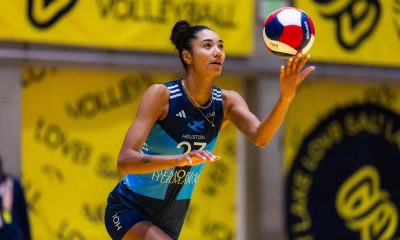
 Sports3 weeks ago
Sports3 weeks agoTwo Pro Volleyball Leagues Serve Up Plans for Minnesota Teams
-

 Sports3 weeks ago
Sports3 weeks agoUtah State Announces 2025-26 Indoor Track & Field Schedule
-
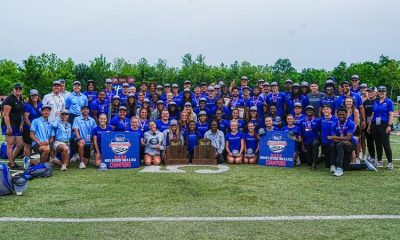
 Sports3 weeks ago
Sports3 weeks agoSycamores unveil 2026 track and field schedule
-

 Motorsports2 weeks ago
Motorsports2 weeks agoRedemption Means First Pro Stock World Championship for Dallas Glenn
-

 Sports3 weeks ago
Sports3 weeks agoTexas volleyball vs Kentucky game score: Live SEC tournament updates
-
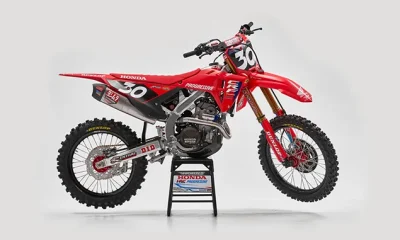
 Motorsports2 weeks ago
Motorsports2 weeks agoJo Shimoda Undergoes Back Surgery
-

 Rec Sports2 weeks ago
Rec Sports2 weeks agoRobert “Bobby” Lewis Hardin, 56
-

 Rec Sports2 weeks ago
Rec Sports2 weeks agoHow this startup (and a KC sports icon) turned young players into card-carrying legends overnight


























